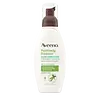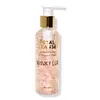What's inside
What's inside
 Key Ingredients
Key Ingredients

 Benefits
Benefits

 Concerns
Concerns

 Ingredients Side-by-side
Ingredients Side-by-side

Salicylic Acid 0.5%
MaskingButylene Glycol
HumectantCitric Acid
BufferingCocamidopropyl Betaine
CleansingDisodium EDTA
Disodium Lauroamphodiacetate
CleansingParfum
MaskingGlycerin
HumectantGlycine Soja Protein
EmulsifyingPEG-16 Soy Sterol
EmulsifyingPEG-6 Caprylic/Capric Glycerides
EmulsifyingPolysorbate 20
EmulsifyingSodium Benzoate
MaskingSodium C14-16 Olefin Sulfonate
CleansingSorbitol
HumectantWater
Skin ConditioningXanthan Gum
EmulsifyingSalicylic Acid 0.5%, Butylene Glycol, Citric Acid, Cocamidopropyl Betaine, Disodium EDTA, Disodium Lauroamphodiacetate, Parfum, Glycerin, Glycine Soja Protein, PEG-16 Soy Sterol, PEG-6 Caprylic/Capric Glycerides, Polysorbate 20, Sodium Benzoate, Sodium C14-16 Olefin Sulfonate, Sorbitol, Water, Xanthan Gum
Water
Skin ConditioningSodium C14-16 Olefin Sulfonate
CleansingGlycerin
HumectantPolysorbate 20
EmulsifyingGlycereth-18 Ethylhexanoate
Skin ConditioningCocamidopropyl Betaine
CleansingActinidia Chinensis Fruit Juice
Skin ConditioningDehydroxanthan Gum
Emulsion StabilisingTriethyl Citrate
MaskingDisodium Cocoyl Glutamate
CleansingGlycereth-18
HumectantSodium Cocoyl Glutamate
CleansingDisodium EDTA
Sodium Ascorbyl Phosphate
AntioxidantRosa Damascena Flower Water
MaskingIsomalt
HumectantButylene Glycol
HumectantCitrus Aurantium Bergamia Fruit Extract
Skin ConditioningCitrus Aurantium Dulcis Peel Extract
Emulsion StabilisingGuaiacum Officinale Wood Extract
PerfumingSantalum Album Wood Extract
PerfumingLeuconostoc/Radish Root Ferment Filtrate
AntimicrobialTrifolium Pratense Extract
Skin ConditioningAlcohol
AntimicrobialAnanas Sativus Fruit Extract
Skin ConditioningCitrus Grandis Peel Extract
AstringentCitrus Nobilis Fruit Extract
MaskingCucumis Melo Cantalupensis Fruit Extract
AstringentElettaria Cardamomum Seed Extract
PerfumingJuniperus Virginiana Wood Extract
PerfumingLavandula Angustifolia Flower/Leaf/Stem Extract
MaskingPelargonium Graveolens Extract
MaskingPunica Granatum Fruit Extract
AntioxidantPyrus Malus Fruit Extract
Skin ConditioningRose Extract
Skin ConditioningVanilla Planifolia Fruit Extract
Skin Conditioning1,2-Hexanediol
Skin ConditioningAgar
MaskingCalcium Alginate
MaskingCaprylyl Glycol
EmollientGellan Gum
CI 77891
Cosmetic ColorantPhytol
EmollientEthylhexylglycerin
Skin ConditioningPhenoxyethanol
PreservativePotassium Sorbate
PreservativeSodium Benzoate
MaskingCitric Acid
BufferingMethylchloroisothiazolinone
PreservativeMethylisothiazolinone
PreservativeCI 73360
Cosmetic ColorantLimonene
PerfumingHydroxycitronellal
PerfumingWater, Sodium C14-16 Olefin Sulfonate, Glycerin, Polysorbate 20, Glycereth-18 Ethylhexanoate, Cocamidopropyl Betaine, Actinidia Chinensis Fruit Juice, Dehydroxanthan Gum, Triethyl Citrate, Disodium Cocoyl Glutamate, Glycereth-18, Sodium Cocoyl Glutamate, Disodium EDTA, Sodium Ascorbyl Phosphate, Rosa Damascena Flower Water, Isomalt, Butylene Glycol, Citrus Aurantium Bergamia Fruit Extract, Citrus Aurantium Dulcis Peel Extract, Guaiacum Officinale Wood Extract, Santalum Album Wood Extract, Leuconostoc/Radish Root Ferment Filtrate, Trifolium Pratense Extract, Alcohol, Ananas Sativus Fruit Extract, Citrus Grandis Peel Extract, Citrus Nobilis Fruit Extract, Cucumis Melo Cantalupensis Fruit Extract, Elettaria Cardamomum Seed Extract, Juniperus Virginiana Wood Extract, Lavandula Angustifolia Flower/Leaf/Stem Extract, Pelargonium Graveolens Extract, Punica Granatum Fruit Extract, Pyrus Malus Fruit Extract, Rose Extract, Vanilla Planifolia Fruit Extract, 1,2-Hexanediol, Agar, Calcium Alginate, Caprylyl Glycol, Gellan Gum, CI 77891, Phytol, Ethylhexylglycerin, Phenoxyethanol, Potassium Sorbate, Sodium Benzoate, Citric Acid, Methylchloroisothiazolinone, Methylisothiazolinone, CI 73360, Limonene, Hydroxycitronellal
 Reviews
Reviews

Ingredients Explained
These ingredients are found in both products.
Ingredients higher up in an ingredient list are typically present in a larger amount.
Butylene Glycol (or BG) is used within cosmetic products for a few different reasons:
Overall, Butylene Glycol is a safe and well-rounded ingredient that works well with other ingredients.
Though this ingredient works well with most skin types, some people with sensitive skin may experience a reaction such as allergic rashes, closed comedones, or itchiness.
Learn more about Butylene GlycolCitric Acid is an alpha hydroxy acid (AHA) naturally found in citrus fruits like oranges, lemons, and limes.
Like other AHAs, citric acid can exfoliate skin by breaking down the bonds that hold dead skin cells together. This helps reveal smoother and brighter skin underneath.
However, this exfoliating effect only happens at high concentrations (20%) which can be hard to find in cosmetic products.
Due to this, citric acid is usually included in small amounts as a pH adjuster. This helps keep products slightly more acidic and compatible with skin's natural pH.
In skincare formulas, citric acid can:
While it can provide some skin benefits, research shows lactic acid and glycolic acid are generally more effective and less irritating exfoliants.
Most citric acid used in skincare today is made by fermenting sugars (usually from molasses). This synthetic version is identical to the natural citrus form but easier to stabilize and use in formulations.
Read more about some other popular AHA's here:
Learn more about Citric AcidCocamidopropyl Betaine is a fatty acid created by mixing similar compounds in coconut oil and dimethylaminopropylamine, a compound with two amino groups.
This ingredient is a surfactant and cleanser. It helps gather the dirt, pollutants, and other impurities in your skin to be washed away. It also helps thicken a product and make the texture more creamy.
Being created from coconut oil means Cocamidopropyl Betaine is hydrating for the skin.
While Cocamidopropyl Betaine was believed to be an allergen, a study from 2012 disproved this. It found two compounds in unpure Cocamidopropyl Betaine to be the irritants: aminoamide and 3-dimethylaminopropylamine. High-grade and pure Cocamidopropyl Betaine did not induce allergic reactions during this study.
Learn more about Cocamidopropyl BetaineDisodium EDTA plays a role in making products more stable by aiding other preservatives.
It is a chelating agent, meaning it neutralizes metal ions that may be found in a product.
Disodium EDTA is a salt of edetic acid and is found to be safe in cosmetic ingredients.
Learn more about Disodium EDTAGlycerin is already naturally found in your skin. It helps moisturize and protect your skin.
A study from 2016 found glycerin to be more effective as a humectant than AHAs and hyaluronic acid.
As a humectant, it helps the skin stay hydrated by pulling moisture to your skin. The low molecular weight of glycerin allows it to pull moisture into the deeper layers of your skin.
Hydrated skin improves your skin barrier; Your skin barrier helps protect against irritants and bacteria.
Glycerin has also been found to have antimicrobial and antiviral properties. Due to these properties, glycerin is often used in wound and burn treatments.
In cosmetics, glycerin is usually derived from plants such as soybean or palm. However, it can also be sourced from animals, such as tallow or animal fat.
This ingredient is organic, colorless, odorless, and non-toxic.
Glycerin is the name for this ingredient in American English. British English uses Glycerol/Glycerine.
Learn more about GlycerinPolysorbate 20 is made by combining ethoxylation of sorbitan, ethylene oxide, and lauric acid. It is a mild cleansing agent, surfactant, and emulsifier.
As a surfactant, it helps collect dirt and oils for washing. Emulsifiers prevent oils and water from separating.
Polysorbate 20 also adds scent to a product. Since it is made using sorbitol, it has a sweet scent. Sorbitol can also be found in fruits such as apples and peaches.
The lauric acid used to create Polysorbate 20 is often derived from coconuts.
Polysorbate 20 may not be fungal acne safe.
Learn more about Polysorbate 20Sodium Benzoate is a preservative. It's used in both cosmetic and food products to inhibit the growth of mold and bacteria. It is typically produced synthetically.
Both the US FDA and EU Health Committee have approved the use of sodium benzoate. In the US, levels of 0.1% (of the total product) are allowed.
Sodium benzoate works as a preservative by inhibiting the growth of bacteria inside of cells. It prevents the cell from fermenting a type of sugar using an enzyme called phosphofructokinase.
It is the salt of benzoic acid. Foods containing sodium benzoate include soda, salad dressings, condiments, fruit juices, wines, and snack foods.
Studies for using ascorbic acid and sodium benzoate in cosmetics are lacking, especially in skincare routines with multiple steps.
We always recommend speaking with a professional, such as a dermatologist, if you have any concerns.
Learn more about Sodium BenzoateSodium C14-16 Olefin Sulfonate is a cleansing agent made from a mixture of long chain sulfonate salts. It can also help produce foam.
This ingredient may be drying. We recommend speaking with a professional if you have concerns.
Water. It's the most common cosmetic ingredient of all. You'll usually see it at the top of ingredient lists, meaning that it makes up the largest part of the product.
So why is it so popular? Water most often acts as a solvent - this means that it helps dissolve other ingredients into the formulation.
You'll also recognize water as that liquid we all need to stay alive. If you see this, drink a glass of water. Stay hydrated!
Learn more about Water